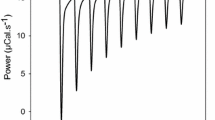Abstract
IN the course of purification studies of polynucleotide phosphorylase (polyase) from M. lysodeikticus we have on several occasions noticed that, after dialysis against buffers at low ionic strength or distilled water, considerable loss of enzyme activity occurred. With the addition of a salt such as sodium acetate or potassium chloride the activity of the enzyme was restored. The activation by potassium chloride of the polymerization of adenylic acid from adenosine diphosphate, determined by rate of release of orthophosphate at pH 9.5, is shown in Fig. 1. The optimum salt concentration is 0.2 M potassium chloride. Higher concentrations of the salt become inhibitory. Parallel studies based on the determination of polymer concentrations yielded identical results1. The following salts activate in the order: KCl > NaCl > Na2SO4 = HCOONa > CH3COONa > LiCl.
Similar content being viewed by others
References
Beers, jun., R. F., Nature, 177, 790 (1956).
Beers, jun., R. F., Biochem. J., [66, 686 (1957)].
Author information
Authors and Affiliations
Rights and permissions
About this article
Cite this article
BEERS, R. Activation of Polynucleotide Phosphorylase by Salts. Nature 180, 246–247 (1957). https://doi.org/10.1038/180246a0
Issue Date:
DOI: https://doi.org/10.1038/180246a0
- Springer Nature Limited
This article is cited by
-
The isolation of polynucleotide phosphorylase from animal tissues
Bulletin of Experimental Biology and Medicine (1959)
-
Inhibition and Activation of Polynucleotide Phosphorylase through the Formation of Complexes between Acridine Orange and Polynucleotides
Nature (1958)





